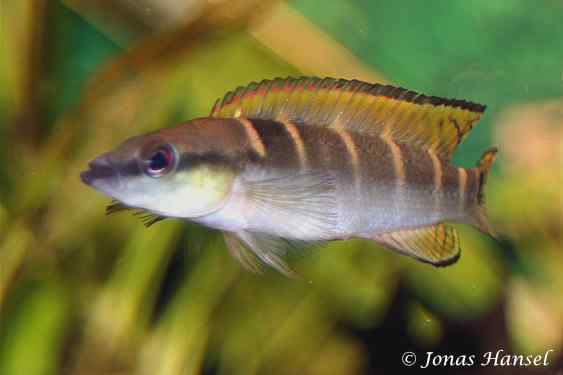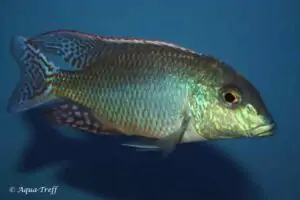Crenicichla compressiceps – Compressiceps Dwarf Pike Cichlid
Crenicichla compressiceps was described in 1986 by Ploeg. Their common name is Compressiceps Dwarf Pike Cichlid.
Origin
South America: lower reaches of the Rio Tocantins, province of Pará, Brazil.
The Aquarium
It is advisable to keep a male with 1-2 females: an aquarium of 100-120 centimetres is usually sufficient for a harem. However, a proven (breeding) pair of Dwarf Pike Cichlids can be kept in a smaller aquarium: 80 centimetres in length will in many cases be sufficient.
Males are often very intolerant to each other. If you want to keep several Crenicichla compressiceps males, a larger aquarium is necessary. A length of about 120 centimeters is the absolute minimum.
The aquarium should be fairly densely planted, with dim lighting, so that the fish feel safe and can hide, especially if they live with larger or very active fish. Pieces of (drift) wood are also very suitable as a shelter and even as a nest location.
Although the Compressiceps Dwarf Pike Cichlid is a hardy and adaptable species, soft, slightly acidic water is preferred (something that can be accomplished by filtering over peat or adding black water extract to the water). In addition, the water must be well aerated and this species likes a little flow in the water. A flow pump and an air pump or diffuser are therefore recommended.
The males can reach a length of about 7-8 centimeters. The females remain a bit smaller with their 5 to 6 centimeters.
Character
Although the Compressiceps Dwarf Pike Cichlid is one of the smallest Crenicichla species, it is in no way inferior to its (often much) larger relatives in terms of temperament. This is an active and very lively, sometimes even aggressive fish that should only be kept with larger fish (anything that fits in the mouth is a potential addition to their daily diet).
The ideal group composition is 1 male and 2 to 3 females, as males are very territorial in nature, especially during spawning.
Water parameters
Temperature: 24-30 degrees Celsius.
PH: 5.5-7,5
GH: 0-4
In nature, fish have to deal with fluctuating temperatures. Keeping fish at the minimum or maximum temperature for a long time is not always desirable and can shorten the average lifespan of the animals.

Diet
Crenicichla compressiceps is a voracious eater with a strong preference for meaty food. Small live foods such as brine shrimp, bloodworms, and even small fish * are particularly appreciated. Frozen foods such as bloodworms, mosquito larvae, krill, brine shrimp and dry food such as small pellets and granules are also generally accepted without any problem, although it can be somewhat difficult at first to get the animals to eat non-live food. This can be overcome by keeping them together with other robust companion fish such as somewhat larger Tetra species, Silver Dollar, or Barbels: fish that eat their food in all layers of the aquarium.
Pike cichlids are quick learners and generally adapt their behavior quickly, and will more readily accept non-live food over time.
It should be taken into account that smaller Crenicichla species are not true surface eaters. Often the animals do not dare, or only after much hesitation, to come to the surface during feeding time. This can make them somewhat oppressed during feeding time if kept together with more assertive fish that eat their food in all layers of the aquarium. For this reason, it is advisable to regularly offer sinking food such as granulated food. Also offering food at different places in the aquarium can help with this.
* When feeding live fish, a number of things should be considered: First, all fish can introduce diseases and/or parasites into the aquarium, including goldfish, windes, and other commonly used cold water fish as well as tropical fish. It is therefore also advisable to first keep feed fish in a quarantine aquarium for a week or 2, in order to “flush” out the sick and weakened specimens. In addition, it should be taken into account that goldfish and close relatives are not particularly nutritious. A diet that usually consists of live fish is therefore not recommended. All the more because goldfish and other Cyprinidae (carp-like) contain hormones – so-called “Thiaminase / Vitamin B1 inhibitors” – that paralyze the production of certain growth-stimulating substances in predatory fish. A very one-sided goldfish diet can therefore lead to growth and development disorders!
Breeding Crenicichla compressiceps
Breeding Crenicichla compressiceps in captivity is very hard. Not much is known about breeding them.
Video
Authors
Jonas Hansel – Piranha-info.com
Coby
Copyright images
F. Ingemann Hansen – Akvariefotografen.com
Jonas Hansel – Piranha-info.com































Reviews
There are no reviews yet.